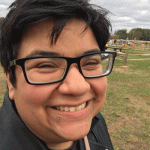
Teresa Williams
Ph.D. Candidate
Graduate Coordinator
They/Them
Email: will3387@msu.edu
Research Areas
Multimodal composing, digital rhetoric, digital literacy, queer rhetorics, writing center studies, visual design, coding, web design, genre studies
Profile
Teresa Williams is a fifth-year PhD candidate. They graduated from Grand Valley State University in 2017 with a BA in Writing and minors in LGBT Studies and Applied Linguistics. They received their MA in Digital Rhetoric and Professional Writing from MSU. Their primary foci are on professional writing, experience architecture, multimodal composing, and digital rhetoric. They are also interested in writing center studies, specifically on how writing centers can assist students with multimodal work. Currently, they are the Media Coordinator at the Writing Center @ MSU.
Education
M.A. in Digital Rhetoric and Professional Writing, Michigan State University
B.A. in Writing, Grand Valley State University
Representative Work
Lauren, Benjamin, Stuart Blythe , & Teresa Williams. “Rhetorics of Basic Needs on College Campuses: Networks, Systems, and Materiality.” Rhetoric Society of America Conference, 2020. (Accepted but cancelled due to COVID).
Williams, Teresa. “Averted Vision: Professional Writing Capstones as Commonplace.” Conference on College Composition and Communication, 2020. (Accepted but cancelled due to COVID).
Williams, Teresa & Andrew Appleton Pine. “The Story at the Center: Websites as Storytelling Sites.” East Central Writing Center Association, 2020.
Williams, Teresa “If You Build It, They Will Come: Creating Space for Multimodal Projects in the Writing Center.” National Conference on Peer Tutoring in Writing, 2016.
Williams, Teresa, Brienne Forgette, and Meghan Forrest. “Mother Tongue: Perspectives on Linguistic Discrimination and Inclusion in the Writing Center.” Michigan Writing Center Association Conference, 2016.
Williams, Teresa. “Practice, Practice, Practice: Working with Multimodal Texts.” Eastern Central Writing Center Association Conference, 2016.
Williams, Teresa. “Beyond Text: Multimodality and the Writing Center.” National Conference on Peer Tutoring in Writing, 2015.
Williams, Teresa. “Peer to Peer to Peer: Mentorship and Communication Within Writing Centers.” Michigan Writing Center Association Conference, 2015.
Sample Courses Taught
WRA 101: Writing as Inquiry
AL 242: Introduction to Experience Architecture
Research or Academic Affiliations
WIDE
The Writing Center @ MSU
East Central Writing Center Association
Association for Teachers of Technical Writing
Social Media
Twitter: @tlwilliams92